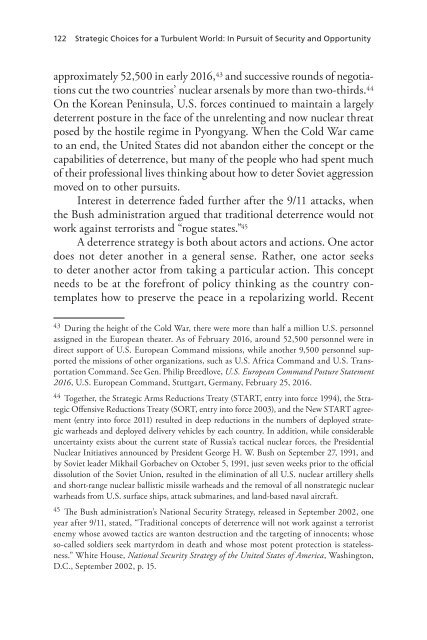Create successful ePaper yourself
Turn your PDF publications into a flip-book with our unique Google optimized e-Paper software.
122 Strategic Choices for a Turbulent World: In Pursuit of Security and Opportunity<br />
approximately 52,500 in early 2016, 43 and successive rounds of negotiations<br />
cut the two countries’ nuclear arsenals by more than two-thirds. 44<br />
On the Korean Peninsula, U.S. forces continued to maintain a largely<br />
deterrent posture in the face of the unrelenting and now nuclear threat<br />
posed by the hostile regime in Pyongyang. When the Cold War came<br />
to an end, the United States did not abandon either the concept or the<br />
capabilities of deterrence, but many of the people who had spent much<br />
of their professional lives thinking about how to deter Soviet aggression<br />
moved on to other pursuits.<br />
Interest in deterrence faded further after the 9/11 attacks, when<br />
the Bush administration argued that traditional deterrence would not<br />
work against terrorists and “rogue states.” 45<br />
A deterrence strategy is both about actors and actions. One actor<br />
does not deter another in a general sense. Rather, one actor seeks<br />
to deter another actor from taking a particular action. This concept<br />
needs to be at the forefront of policy thinking as the country contemplates<br />
how to preserve the peace in a repolarizing world. Recent<br />
43 During the height of the Cold War, there were more than half a million U.S. personnel<br />
assigned in the European theater. As of February 2016, around 52,500 personnel were in<br />
direct support of U.S. European Command missions, while another 9,500 personnel supported<br />
the missions of other organizations, such as U.S. Africa Command and U.S. Transportation<br />
Command. See Gen. Philip Breedlove, U.S. European Command Posture Statement<br />
2016, U.S. European Command, Stuttgart, Germany, February 25, 2016.<br />
44 Together, the Strategic Arms Reductions Treaty (START, entry into force 1994), the Strategic<br />
Offensive Reductions Treaty (SORT, entry into force 2003), and the New START agreement<br />
(entry into force 2011) resulted in deep reductions in the numbers of deployed strategic<br />
warheads and deployed delivery vehicles by each country. In addition, while considerable<br />
uncertainty exists about the current state of Russia’s tactical nuclear forces, the Presidential<br />
Nuclear Initiatives announced by President George H. W. Bush on September 27, 1991, and<br />
by Soviet leader Mikhail Gorbachev on October 5, 1991, just seven weeks prior to the official<br />
dissolution of the Soviet Union, resulted in the elimination of all U.S. nuclear artillery shells<br />
and short-range nuclear ballistic missile warheads and the removal of all nonstrategic nuclear<br />
warheads from U.S. surface ships, attack submarines, and land-based naval aircraft.<br />
45 The Bush administration’s National Security Strategy, released in September 2002, one<br />
year after 9/11, stated, “Traditional concepts of deterrence will not work against a terrorist<br />
enemy whose avowed tactics are wanton destruction and the targeting of innocents; whose<br />
so-called soldiers seek martyrdom in death and whose most potent protection is statelessness.”<br />
White House, National Security Strategy of the United States of America, Washington,<br />
D.C., September 2002, p. 15.




